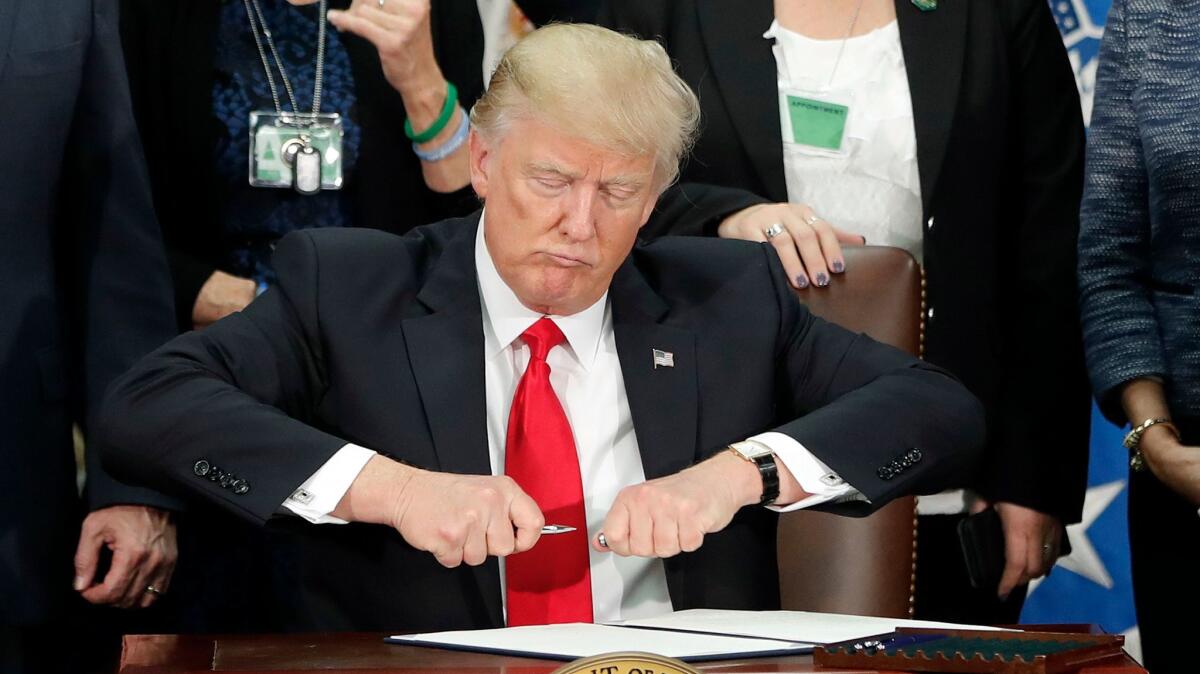Op-Ed: The best ism to explain our time: Surrealism, which turns 100 this year

- Share via
Surrealism is celebrating its 100th birthday this year. The poet Guillaume Apollinaire coined the term to describe his play “Les Mamelles de Tiresias” (The Teats of Tiresias), which opened in a small Parisian theater in 1917. Beginning with an actress removing her breasts and ending early with an unscripted riot — featuring a pistol-flailing audience member — the play launched a movement that long convulsed French art and politics.
The centenary arrives in a surreal news environment. Indeed, among the dozens of isms used to explain the Trump presidency — from isolationism and pluto-populism to narcissism and authoritarianism — none does a better job than surrealism in capturing the current mood.
André Breton, the “Pope of Surrealism,” defined it as a “psychic automatism in its pure state … exempt from any moral concern.” In his First Manifesto of Surrealism, Breton railed against rationalism and the “reign of logic.” Clarity and coherence lost bigly to the tumult of unconscious desires, while civility and courtesy were for bourgeois losers. Upping the ante in his Second Manifesto, he claimed the simplest Surrealist act “consists of dashing down into the street, pistol in hand, and firing blindly, as fast as you can pull the trigger, into the crowd.”
Unarmed Surrealists were content to brandish their ids. What was once the stuff of repression was now ripe for expression. Everything that welled up into the conscious mind flowed across paper and canvas. The true Surrealist turns his mind into a “receptacle,” refusing to “favor one group of words over another.” Instead, it is “up to the miraculous equivalent to intervene.”
Trumpian word salads bear the surrealist seal of absurdity.
Or not. As a sober reader finds, most Surrealist literature is unreadable. The precursor to Surrealism, the Romanian Tristan Tzara, famously composed poems by cutting words from a newspaper, tossing them into a bag, pulling them out and reciting them one by one. The result, Tzara declared, “will resemble you.” (Perhaps that’s true if you happen to be crashed on your kitchen floor, sleeping off an all-night bender.) As for Breton, he favored “automatic writing” by becoming a “recording machine” for his unconscious. The final product, he beamed, shines by its “extreme degree of immediate absurdity.”
Trumpian word salads bear the surrealist seal of absurdity. In Exquisite Corpse — a Surrealist exercise aimed at unleashing the unconscious — you write a word on a piece of paper, pass it to your neighbor who jots a second word without looking at the first word, and so on. This led to sentences like “The exquisite/corpse/shall drink/the new/wine.” Trump’s gift of free association — “His one problem is he didn’t go to Russia that night because he had extracurricular activities, and they froze to death” — allows him to play a solitaire variation of the game.
A French translator recently marveled that Trump seems to have “thematic clouds in his head that he would pick from with no need of a logical thread to link them.” This is true not just of his speech, but also of his governing strategy.
Igniting a reaction similar to those following Marcel Duchamp entering a urinal at an art show, Trump has exhibited his Surrealist aesthetic in bureaucratic Washington. But he subverts ready-made expectations instead of ready-made objects. With a Surrealist flair for showmanship worthy of Salvador Dali, he randomly pairs titles and individuals. Thus, his son-in-law, a New York real estate developer, plays Middle East envoy one day, opioid crisis czar the next. Trump’s claim that if Jared Kushner cannot bring peace to the Middle East, no one can expresses the Surrealist conviction that where reason and strategy have failed, unreason and whim will prevail.
The same aesthetic lies behind — or, rather, below — the Wall. Its failure to make economic, strategic or diplomatic sense is not beside the point; it is the point. Its raison d’être is to shock the political establishment and to give shape to what, until now, had been the repressed desires of Trump’s base. Think of it not as a real security measure, but as a virtual sculpture that will allow its audience to touch, and not just talk about their phobias. Like a Surrealist object, the Wall is a shape-shifter — opaque or transparent, continuous or discontinuous, topped with barbed wire or solar panels — and expresses the Surrealist values of excess and extravagance, aggression and transgression.
In the end, Trumpism, like Surrealism, seeks to force reality to conform to individual desires, no matter how illicit, illegal or simply outrageous. This might work aesthetically, even financially — just ask Dali, whose name Breton turned into the anagram Avida Dollars — and, it seems, politically. But, one can hope, only in the short term.
Eventually, Surrealism’s revolt against the “reality-based community” ended with a whimper, with its art relegated to post-dinner games and dorm room posters. One day, perhaps, politicians will look back on Trumpism in the same dismissive way.
Robert Zaretsky teaches at the University of Houston and is finishing a book on Catherine the Great and the French Enlightenment.
Follow the Opinion section on Twitter @latimesopinion or Facebook
More to Read
A cure for the common opinion
Get thought-provoking perspectives with our weekly newsletter.
You may occasionally receive promotional content from the Los Angeles Times.










